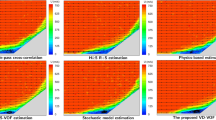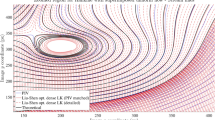Abstract
In this paper, we propose a novel optical flow method to estimate the velocity fields of fluid sequences based on spatial–temporal physical principles. Our novel optical flow model mainly takes scalar field correspondence, velocity field temporal coherence and incompressibility into consideration. And the velocity field smoothness assumption is also used for better convergence. Compared with existing methods which only estimate the velocity field between a single pair of frames, our novel optical flow model can deal with the fields of all frames of the sequence simultaneously. For some frames of the sequence, the image quality is higher and more accurate velocity fields can be obtained, but for other frames, the estimated fields may be rather far from the groundtruth due to the lack of information. And our model can propagate the correspondence information from the accurate frames to neighbor frames and help the optimization converge to a better result. Also, several sophisticated optimization techniques are employed to solve our novel model efficiently and robustly.








Similar content being viewed by others
References
Ihrke, I., Magnor, M.: Image-based tomographic reconstruction of flames. In: Proceedings of the 2004 ACM SIGGRAPH/Eurographics Symposium on Computer Animation, SCA ’04, pp. 365–373 (2004)
Hawkins, T., Einarsson, P., Debevec, P.: Acquisition of time-varying participating media. ACM Trans. Graph. 24(3), 812–815 (2005)
Hu, Y., Yue, Q., Xin, T.: Image-based modeling of inhomogeneous single-scattering participating media. Sci. China Inform. Sci. 53(6), 1141–1150 (2010)
Wang, H., Liao, M., Zhang, Q., Yang, R., Turk, G.: Physically guided liquid surface modeling from videos. ACM Trans. Graph 28(3), 90:1–90:11 (2009)
Gregson, J., Krimerman, M., Hullin, M.B., Heidrich, W.: Stochastic tomography and its applications in 3d imaging of mixing fluids. ACM Trans. Gr. 31(4), 7
Bhat, K.S., Seitz, S.M., Hodgins, J.K., Khosla, P.K.: Flow-based video synthesis and editing. ACM Trans. Graph. 23(3), 360–363 (2004)
Pighin, F., Cohen, J.M., Shah, M.: Modeling and editing flows using advected radial basis functions. In: Proceedings of the 2004 ACM SIGGRAPH/Eurographics Symposium on Computer Animation, SCA ’04, pp. 223–232, Aire-la-Ville, Switzerland, Switzerland, 2004. Eurographics Association
Okabe, M., Anjyor, K., Onai, R.: Creating fluid animation from a single image using video database. Comput. Gr. Forum 30(7), 1973–1982 (2011)
Gregson, J., Ihrke, I., Thuerey, N., Heidrich, W.: From capture to simulation—connecting forward and inverse problems in fluids. ACM Trans. Gr. 33 (2014)
Ke, Y., Sukthankar, R.: Pca-sift: a more distinctive representation for local image descriptors. In: Proceedings of the 2004 IEEE Computer Society Conference on Computer Vision and Pattern Recognition, 2004. CVPR 2004, vol. 2, pp. II–506–II–513, June 2004
Horn, B.K., Schunck, B.G.: Determining optical flow. Artif. Intell. 17(1–3), 185–203 (1981)
The robust estimation of multiple motions: Parametric and piecewise-smooth flow fields. Comput. Vis. Image Underst. 63(1), 75–104 (1996)
Memin, E., Perez, P.: A multigrid approach for hierarchical motion estimation. In: Sixth International Conference on Computer Vision, pp. 933–938, Jan 1998
Gupta, S.N., Prince, J.L.: Stochastic models for div-curl optical flow methods. IEEE Signal Process. Lett. 3(2), 32–34 (1996)
Corpetti, T., Memin, E., Perez, P.: Dense estimation of fluid flows. IEEE Trans. Pattern Anal. Mach. Intell. 24(3), 365–380 (2002)
Ruhnau, P., Stahl, A., Schnörr, C.: Variational estimation of experimental fluid flows with physics-based spatio-temporal regularization. Meas. Sci. Technol. 18(3), 755 (2007)
Brox, T., Bruhn, A., Papenberg, N., Weickert, J.: High accuracy optical flow estimation based on a theory for warping. Computer Vision—ECCV 2004, volume 3024 of Lecture Notes in Computer Science, pp. 25–36. Springer, Berlin (2004)
Sun, D., Roth, S., Black, M.J. Secrets of optical flow estimation and their principles. In: 2010 IEEE Conference on Computer Vision and Pattern Recognition (CVPR), pp. 2432–2439, June 2010
Volz, S., Bruhn, A., Valgaerts, L., Zimmer, H.: Modeling temporal coherence for optical flow. In: 2011 IEEE International Conference on Computer Vision (ICCV), pp. 1116–1123 (2011)
Keane, R.D., Adrian, R.J.: Optimization of particle image velocimeters. I. Double pulsed systems. Meas. Sci. Technol. 1(11), 1202 (1990)
Keane, R.D., Adrian, R.J.: Theory of cross-correlation analysis of piv images. Appl. Sci. Res. 49(3), 191–215 (1992)
Corpetti, T., Mmin, T., Prez, P.: Estimating fluid optical flow. In: Proc. International Conf. on Pattern Recognition, pp. 1045–1048 (2000)
Corpetti, T., Heitz, D., Arroyo, G., Mémin, E., Santa-Cruz, A.: Fluid experimental flow estimation based on an optical-flow scheme. Exp. Fluids 40(1), 80–97 (2006)
Yuan, J., Schnörr, C., Mémin, E.: Discrete orthogonal decomposition and variational fluid flow estimation. J. Math. Imaging Vis. 28(1), 67–80 (2007)
Herlin, I., Béréziat, D., Mercier, N., Zhuk, S.: Divergence-free motion estimation. In: Fitzgibbon, A., Lazebnik, S., Perona, P., Sato, Y., Schmid, C. (eds.) Computer Vision—ECCV 2012, Volume 7575 of Lecture Notes in Computer Science, pp. 15–27. Springer, Berlin (2012)
Kadri-Harouna, S., Dèrian, P., Hèas, P., Mèmin, E.: Divergence-free wavelets and high order regularization. Int. J. Comput. Vis. 103(1), 80–99 (2013)
Ruhnau, P., Schnörr, C.: Optical stokes flow estimation: an imaging-based control approach. Exp. Fluids 42(1), 61–78 (2007)
Heitz, D., Héas, P., Mémin, E., Carlier, J.: Dynamic consistent correlation-variational approach for robust optical flow estimation. Exp. Fluids 45(4), 595–608 (2008)
Parikh, N., Boyd, S.: Proximal algorithms. Found. Trends Optim. 1(3), 123–231 (2013)
Stam, J.: Stable fluids. In: Proceedings of the 26th annual conference on Computer graphics and interactive techniques, pp. 121–128. ACM Press/Addison-Wesley Publishing Co. (1999)
Fedkiw, R., Stam, J., Jensen, H.W.: Visual simulation of smoke. In: Proceedings of the 28th Annual Conference on Computer Graphics and Interactive Techniques, SIGGRAPH ’01, pp. 15–22, New York, NY, USA, 2001. ACM
Nvidia cuda home page. http://www.nvidia.com/object/cuda_home_new.html
Konstantinidis, E., Cotronis, Y.: Accelerating the red/black sor method using gpus with cuda. Parallel Processing and Applied Mathematics. volume 7203 of Lecture Notes in Computer Science, pp. 589–598. Springer, Berlin (2012)
Acknowledgments
This paper was supported by the National Key Technology Research and Development Program of China (No. 2014BAK18B01), National Natural Science Foundation of China (Nos. 61272348, 61202235), Ph.D. Program Foundation of Ministry of Education of China (No. 20111102110018).
Author information
Authors and Affiliations
Corresponding author
Electronic supplementary material
Below is the link to the electronic supplementary material.
Rights and permissions
About this article
Cite this article
Zuo, Q., Qi, Y. A novel spatial–temporal optical flow method for estimating the velocity fields of a fluid sequence. Vis Comput 33, 293–302 (2017). https://doi.org/10.1007/s00371-015-1195-7
Published:
Issue Date:
DOI: https://doi.org/10.1007/s00371-015-1195-7




